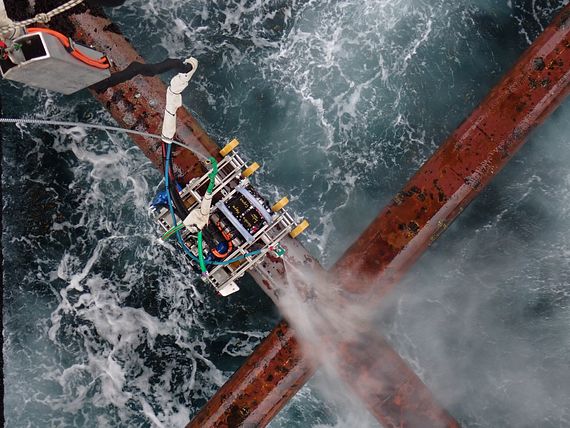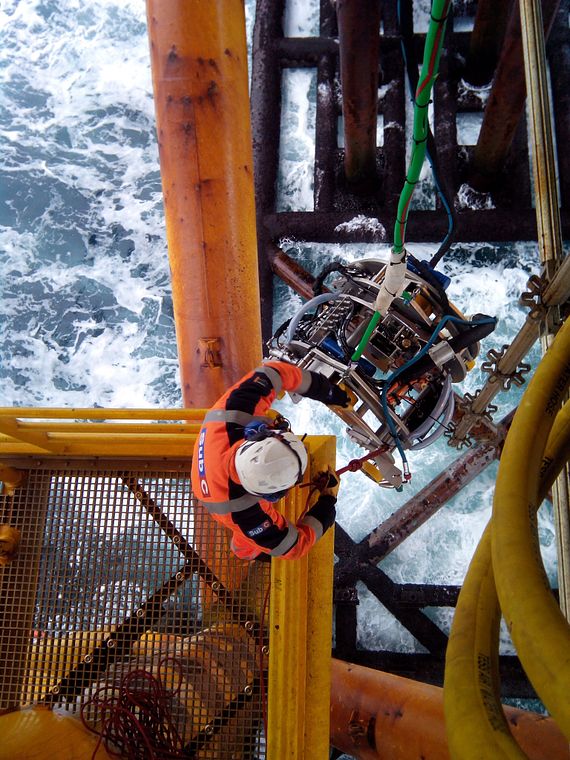Bearing points in inspection robots defy the rough North Sea
It cleans, inspects and removes steel structures on the Danish gas platform: Tyra the Robotic Crawler, a robot that eliminates the need for dangerous and expensive dives. To protect the robot against corrosion and wear during its work in the harsh North Sea, the engineers rely on high-performance polymers from the motion plastics specialist igus.
The next time you holiday in Denmark and turn on the gas stove, bear in mind: with a probability of 90 per cent, the gas comes from the Danish North Sea. Pumped from a platform called Tyra, which the company Total has been operating since 1987, located 200 kilometres west of the city of Esbjerg. But Tyra is in danger. Because the porous limestone layers under the seabed are diminishing. The seabed - and the gas platform - has sunk by over five metres in recent decades. This has brought the platform so close to the water that high waves in winter become a danger to employees. Therefore, Total has decided to rebuild the gas platform. Gas production has been discontinued until 2022. Construction work has been scheduled.
The next time you holiday in Denmark and turn on the gas stove, bear in mind: with a probability of 90 per cent, the gas comes from the Danish North Sea. Pumped from a platform called Tyra, which the company Total has been operating since 1987, located 200 kilometres west of the city of Esbjerg. But Tyra is in danger. Because the porous limestone layers under the seabed are diminishing. The seabed - and the gas platform - has sunk by over five metres in recent decades. This has brought the platform so close to the water that high waves in winter become a danger to employees. Therefore, Total has decided to rebuild the gas platform. Gas production has been discontinued until 2022. Construction work has been scheduled.

Problem
Since the robots work permanently underwater, seawater resistance is required for the components. In addition, the bearings are subject to a load of up to 500 kg. To achieve the longest possible service life, a wear-resistant bearing is required.Solution
With iglidur J polymer plain bearings, the company SubC has found a very wear-resistant solution that works very well and reliably under the harsh conditions. Due to the freedom from lubrication, the iglidur bearings can be used underwater without danger to the environment. Even with the occurring loads of 30 MPa in combination with salt water, no significant wear of the plain bearings could be detected after 200,000 cycles.Bjarne Lindquist, the Design Engineer in charge at SubC Partner.
Like in a washing machine' - dives are dangerous and expensive
Drilling platforms are mounted on so-called 'jackets' - on square structures made of steel tube anchored to the seabed. The rebuilding project included making an inventory. What about the quality of the steel pipes - especially near the water surface, in the so-called splash zone, where the structure is susceptible to corrosion? To find answers, divers would have jumped into the water in the past. A dangerous task.A 'ride in a washing machine' is how a diver compares the operation. In addition, crew, equipment and support vessels are expensive. Total has therefore been looking for an alternative. The company found what it was looking for in Esbjerg. The Danish city in southwestern Jutland is the headquarters of SubC Partner - a company specialising in the development of offshore technologies. SubC have developed, fabricated and operated the robotic crawler for the inspection of pipes. A special tribute: The robot was awarded an innovation prize by Total.
Safer and more cost-effective: robots for inspection and decommissioning work
The Crawler has two hydraulically powered metal claws with a total of 12 rollers, each clinging to the steel structure with a contact pressure of 500kg. On 12 rollers, the crawler moves around the tube. The forward motion resembles that of a caterpillar: if it wants to move forward, the rear claw clasps the tube. The front claw presses forward by a few centimetres via hydraulic cylinders. Then the front claw pulls the rear one after. In this way the robot reaches any point of the tube.And the control system? The Crawler can be moved using a joystick. It delivers a live image to the command centre via six cameras. From there, the operator also controls the robot tools - mainly a wire diamond cutter that allows the robot to saw and remove parts or structures on the platform.
High performance polymer protects the Robotic Crawler from corrosion
The Robotic Crawler - unlike a diver - does not run the risk of getting injured. But the salty seawater was still a challenge for the engineers. If the experts had used metal bushings in the joints of the robot, the risk of corrosion and unplanned downtime would have been constant companions.The engineers therefore opted for an alternative: bushings made of iglidur high-performance polymer offered by the motion plastics specialist igus based in Cologne. "Thanks to the polymer bushings, we do not have to worry about corrosion anymore," explains Bjarne Lindquist, the Design Engineer in charge at SubC Partner. And so it is not surprising that the engineers are using another igus product. The wire-type diamond cutter moves on drylin linear axes. "Thanks to them we can position the cutter with millimetre accuracy. "
In terms of robustness, the polymer components are not behind. The polymer compounds are mixed with reinforcing materials, which make the bushings so robust that they withstand high pressures and edge loads. "igus has developed polymer products as an alternative to metallic products in industrial professional applications," says Anders Riis Olesen, Technical Sales Consultant at igus. "That's great. " The bushings are also maintenance-free..
Since solid lubricants are integrated in the material, dry operation with a low coefficient of friction is possible without additional lubrication with oils and greases. Last but not least, SubC Partner was able to reduce the Robotic Crawler's cost. The iglidur bushings are up to 40 per cent more cost-effective than metal bushings.

Laboratory tests confirm wear resistance of polymer bearings
In order to prove the durability of its materials, igus operates a 3,800 square metre test laboratory, where more than 15,000 tribology tests are conducted each year on 300 test facilities. Also, iglidur Z, the material used by SubC Partner, had to prove its robustness there. The engineers pivoted a polymer bushing on an ST52 gas-nitrided shaft - at a speed of 0.01 metres per second and a load of 30 MPa. Even after 200,000 cycles, no appreciable wear could be measured on the bushings and the shaft.The result is different with the metallic bushings. The engineers stopped the experiment after 35,000 cycles. Too high was the wear of the bushings, too much damage to the shaft. The iglidur Z was specifically developed for maximum service life under extreme conditions. In addition to its wear resistance to salt water, it is also suitable for high thermal stress and high forces.
To the products used
iglidur Z plain bearings